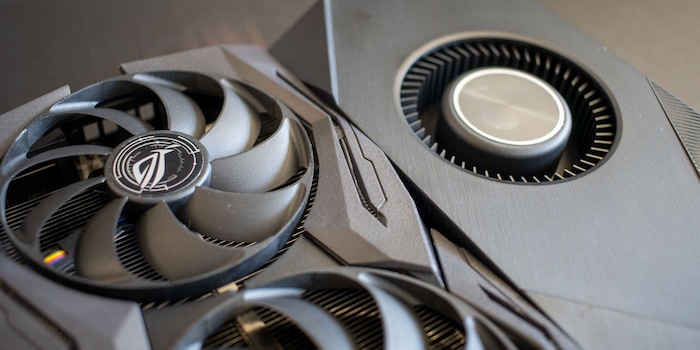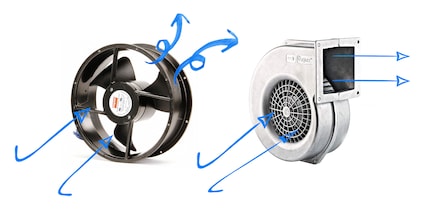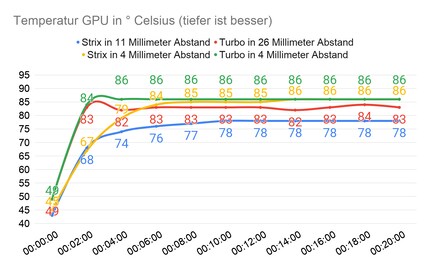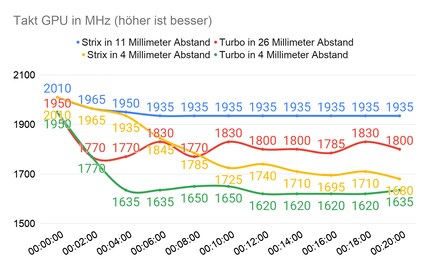
Product test
Axial vs. radial: Two GeForce RTX 2070 Super in a ray tracing comparison test
by Kevin Hofer

How should a graphics card be cooled? With a radial fan or with several axial fans? What makes sense? I investigated these questions. Spoiler: The radial fan makes sense in very few cases.
I recently compared two Geforce RTX 2070 Super graphics cards. One with a radial fan and the suffix Turbo and one with three axial fans, called Strix. The card with the axial fans clearly performed better in terms of cooling performance. So I asked myself the question: Why are radial fans still used on graphics cards at all?
Radial fans draw in fresh air and discharge it in a radius on the other side. In contrast, with axial fans, the incoming air is deflected by the blades and discharged on the other side in spiral paths. Axial fans move relatively large volumes of air with minimal effort. The pressure build-up here depends on the angle that the air flow forms relative to the blade profile. The angle must be increased if more pressure is to be generated. This has its limits: If the angle of attack is too large, the flow breaks off and the fan operates inefficiently. If more pressure is to be generated, radial fans step into the breach. They can generate significantly higher pressure with the same volume. They utilise the centrifugal effect https://mag.ebmpapst.com/de/einblicke/axial-diagonal-radial_2447/

Axial fans swirl the waste heat in the housing. Good airflow is required for the resulting air to escape from the housing. The radial fan, on the other hand, emits the warm air out of the case via the slot bracket at the back of the graphics card.
What does this mean for graphics card fans with axial or radial fans? At first glance, the radial fan is the better choice for the graphics card. However, this is only true to a limited extent. This is because axial fans transport large volumes of air more efficiently. This means that they require lower speeds to transport a comparable amount of air. The cooling performance is therefore better. In addition, graphics cards with radial fans only have one fan installed. Graphics cards with axial fans have up to three. This allows them to be operated at an even lower speed. This generates less noise. Radial fans are a lot louder anyway.
In addition, most newer PC cases are designed for positive pressure. This means that the airflow in the case is better when more fresh air is transported into the case than is expelled. In other words: In newer cases, the hot air can escape through enough air vents. It therefore only plays a subordinate role if the axial fans swirl the air inside the enclosure; it still reaches the outside.
Radial fans make sense where enclosures are not sufficiently ventilated. For example, in servers, where direct ventilation is recommended. Graphics cards with radial fans also have the advantage of being more compact. Depending on the graphics card model, you may only find one with a radial fan for a small form factor build. However, you should bear in mind that the radial fan produces more noise than an axial fan. This is a not insignificant argument for a small form factor build, which is normally placed on the desk or in the living room. Another advantage is the centrifugal effect. Centrifugal fans draw in fresh air more efficiently than axial fans if they cannot draw in air from the front. This is the case with dual GPU setups via SLI from Nvidia or Crossfire from AMD.
I would have liked to test the difference between radial and axial fans in a small case. Unfortunately, the ASUS GeForce RTX 2070S ROG Strix O8G Gaming with its 2.7-slot thickness does not fit into either the H1 from NZXT or the Rocket from Kolink. These two Mini ITX cases are currently available to me. This would be another application for the Turbo or graphics cards with radial fans: they are more compact and therefore fit into small cases. Testing in the two cases would be pointless anyway: Both have sufficient air slots. It is to be expected that a card with axial fans will perform better. I have shown in detail in the review that the Turbo in the H1 is not a good idea. The card is installed vertically and therefore vents towards the bottom. This leads to heat build-up.
That's why I make the comparison on our test bench in two variants. I insert both cards into the neighbouring PCIe slots. First one at the top and then the other at the bottom. This at least approximates operation in SLI - one of the application areas I mentioned above.

In a second step, I place the packaging of the respective graphics card four millimetres away from the fans. I smother them, so to speak. The radial fan of the Asus GeForce Turbo RTX 2070S 8G EVO should have a clear advantage here.
In both scenarios, I run the FurMark GPU stress test for 20 minutes. I also record the temperature, clock frequency and the percentage fan speed with HWiNFO64. For comparison: In my original review on the testbench, the Strix reached a maximum temperature of 62° Celsius and the Turbo 82° Celsius. The noise level from a distance of 30 centimetres was around 42 dB for the Strix and 49 dB for the Turbo. The fans were set to automatic. This is also how I tested this time. The temperatures and volumes were achieved in the original test using the Time Spy benchmark. FurMark, the benchmark I'm using this time, puts the hardware under a little more strain and, above all, for longer. You can therefore expect even higher temperatures for both cards in this test.


Before I discuss the results, here are the results of the sound measurement with corresponding fan strength (always from a distance of 30 centimetres, microphone pointed at the rear connectors of the card):
The Strix has a disadvantage in the simulated test with dual GPU: due to its thickness, it is closer to the Turbo attached to the lower PCIe slot than in the reverse scenario. Nevertheless, the Strix remains cooler. The card is a maximum of 6° Celsius cooler with axial fans. At the same time, the Strix only loses around 2.5 per cent of its original clock frequency. With the Turbo it is almost 7 per cent. The Strix is also ahead in terms of noise: 49 compared to 50.5 dB. That doesn't look like much, but it corresponds to around 19 per cent more, because dB is calculated logarithmically. If I have miscalculated: Write it in the comments column.


Of course, the test is not conclusively representative of dual-GPU setups. I only stress one card during the test, the other is only connected. Unfortunately, I don't have the NVLink to connect both cards together. Nevertheless, I maintain that the axial fans of the Strix are the better choice. If you look at the following gif (Turbo: left, Strix: right) of the heat development of both cards, the Strix gets less hot on the top side. It generates less waste heat in the housing than the Turbo.


Even if the Turbo is vented on the back of the card, it generates more waste heat in the case than the Strix, which is not insignificant for SLI and the heat development in the case.
The Strix also performs better with the four millimetre gap. The one decibel difference is the equivalent of eleven per cent that the Turbo is louder than the Strix. The Strix also wins in terms of temperature. After 20 minutes, both are 86° Celsius warm. However, the Turbo reaches this limit earlier: after just four minutes. The Strix takes ten minutes longer. The drop in performance is enormous for both: the Strix clocks down by almost 20 per cent. With the Turbo it is 19 per cent.
Compared with the pseudo-dual GPU configuration, the performance loss is 15 per cent for the Strix and 10 per cent for the Turbo. This shows the qualities of the radial fan: it is able to cool better in tight spaces. However, it will probably never be as cramped as when tested with the cardboard box in a PC.
The test shows that the radial fan makes no sense even in extreme scenarios with only four millimetres of space for the air supply. The Strix still performs better. This may also be due to the fact that the Strix is equipped with three axial fans and the Turbo with only one radial fan. In dual GPU configurations, however, graphics cards with axial fans are also likely to perform better than those with radial fans.
When does a radial fan on the GPU make sense? If a housing can only be ventilated minimally, for example in a server, or if there is simply no room for graphics cards with axial fans, which are simply thicker. Otherwise, I would always opt for a graphics card with one or more axial fans, depending on the model. From a Geforce RTX 2060 Super upwards, you can have two. Then you just have to make sure that the graphics card is no thicker than 2 slots. It should also fit into modern mini-ITX cases.
From big data to big brother, Cyborgs to Sci-Fi. All aspects of technology and society fascinate me.
Practical solutions for everyday problems with technology, household hacks and much more.
Show all